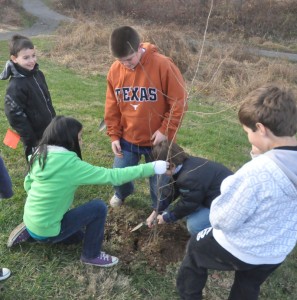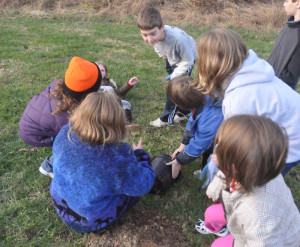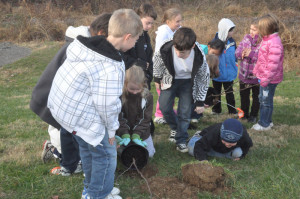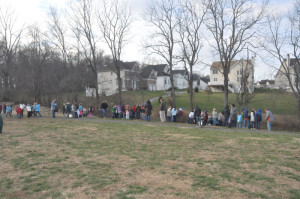School works with Stroud Water Center to plant 250 trees along campus trail
By Mike McGann, Editor, UnionvilleTimes.com

First, second, fourth and fifth grade students at Pocopson Elementary School worked together to plant some 250 trees along the campus' new walking trail, as part of a joint project with the Stroud Water Research Center.—Mike McGann photos
POCOPSON — More than 300 years ago, the rolling hills here would have been covered with trees — displaying the canopy of old-growth forest that helped name the commonwealth.
Centuries of farming cleared the land, but students at Pocopson Elementary School spent time on some recent chilly December afternoons to turn back the clock a bit, at least in ecological terms, working to plant some 250 trees along the new walking trail at the school.
The effort was organized by physical education teacher Allison Tester and Pocopson Parent Teacher Organization President Jodie Weaver. As part of an ongoing process led by school principal Dr. Andrew McLaughlin to seek micro-grants for various school projects — an effort earlier this year cited as an example for the rest of the Unionville-Chadds Ford district by Superintendent Sharon Parker — Tester and Weaver went looking for a grant partner and found a perfect match: the Stroud Water Research Center.

Working under the supervision of teachers, second and fourth grade students were paired up together to plant trees. Earlier in the day, first and fifth graders were paired up similarly.
“The planting at the Pocopson School was attractive to me and the Center from both an environmental and educational perspective,” said Dr. Bernard Sweeney, Director of Stroud Water Research Center. “Adding the trees to nature trail would put the trail in a more natural setting because, although the campus occupies an abandoned farm field, the site was historically an old growth forest and part of ‘Penn’s Woods’ as the name
Pennsylvania implies.”
Stroud was able to secure a grant of $3,248 from the TreeVitalize program, a public-private partnership which has helped to plant nearly a quarter million trees in Pennsylvania in 2010 — with the goal of reaching one million. The grant helped pay for the saplings, which went into the ground this past week, as well as tree shelters, to protect the young trees for the from the elements and the deer. The school’s PTO was able to fund the remainder of the project and the plantings were completed this week.

Second and fourth grade students at Pocopson Elementary School work together to plant trees, Friday.
Tester points to the obvious education opportunities — and environmental and aesthetic improvements to the fairly wide-open hilltop campus as being her prime motivation for wanting to add the trees. Having completed the campus walking trail — which nicely connects with the adjoining Pocopson Township trail and will be able available for public use during non-school hours — Tester said she wanted to improve it. The trees are a first step, she said, hoping to add fitness stations to the nearly one mile of trail, but that will require a new round of grant writing and funding.
Stroud’s Sweeney notes that adding native trees can improve water quality in local streams and rivers — no small consideration, considering the school lies within a couple of hundred yards of the Brandywine, which supplies drinking water for hundreds of thousands of people — a major factor in Stroud’s support for the project. Roughly 20 different species of local trees were planted — a mix selected on the basis on what species have traditionally thrived locally.
The tree planting itself was fairly exciting — the first batch of trees went into the ground Thursday — prompting a visit by a Philadelphia TV station. On Friday, a second batch was planted, this time pairing first and fifth grade students working together, as well as second and fourth grade students working together. The school district’s grounds department had predug the holes, so the students only had to place the tree bundles in the holes and fill them in, working in groups of six to eight.
Having had a role in planting the trees, the students — especially the younger ones — will get the opportunity to observe the growth of trees over the coming years and learn in a first-hand way about the interconnected nature of the local ecosystem.








